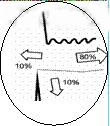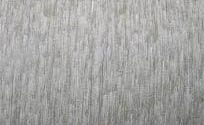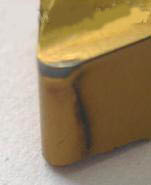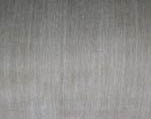1. Cutting characteristics of resin-based glass fiber composites
   The resin-based glass fiber composite material consists of a hard glass fiber and a soft resin matrix, and a resin-based glass fiber composite material wound and formed has a glass fiber content of about 80%. The strength and hardness of the material are greater than 45# steel. And 40Cr steel, while the density is only about 2.2g/cm.
   In the cutting process of resin-based glass fiber composites, the factors influencing the tool life are the same as the cutting of metal materials. The main cutting heat, friction, and cutting edge cutting pressure, and the resin glass fiber composite material in the hard particle glass fiber, Similar to the abrasive in the grinding wheel, grinding the tool causes the tool to wear faster and the cutting conditions deteriorate.

Figure 1: Heat distribution during metal cutting
2. Selection and use of resin-based glass fiber composite cutting tools
A fiberglass-wound tube part is 1300mm long and φ130mm in the outer circle. In order to meet the requirements for fitting with other parts, external circular cutting is required. Due to the special requirements of the part, coolant cannot be used during cutting. This gives Cutting has brought difficulties.
2.1 Carbide Tool Usage
According to the characteristics of the part, we initially chose the indexable carbide tool, mainly considering the heat resistance and wear resistance. The tool selected was an equilateral hexagon with a corner angle of 80°. , 0° relief angle, 6° rake angle, single-sided C-shaped chipbreaker, model WNUM130716RC5 insert, material YT758, this tool is characterized by good heat resistance and oxidation resistance, high temperature hardness, wear resistance Well, it is suitable for machining high hardness materials. When cutting the outer circle of the glass fiber composite part with such a blade, the tool wears badly, and the outer surface of the part is rough with tear marks. During the cutting process, the sharpening head must be removed to continue cutting. The tool can only be turned once by hand, so that each cutting of a part requires sharpening and tooling 2 or 3 times. If the cutting is not sharp, the cutting is performed. It will cause tear marks on the outer surface of the workpiece (see Figure 2). It will even cause excessive heat to burn the workpiece and render the workpiece useless. According to this kind of situation, when cutting, it is divided into coarse and fine two-time processing, which is respectively processed by roughing and fine two-knife clamping and knife-cutting. In roughing, the cutting parameters adopt cutting depth ap=0.8mm, Vc= 130m/min, f=0.61mm/r, fast clearance; in cutting process, cutting depth ap=0.3mm, Vc=130m/min, f=0.3mm/r, and 150# after finishing Emery cloth polished to size. Cutting with such a tool has a low production efficiency, and 7 to 8 pieces are processed per shift. The operator's labor intensity is high, the operator's requirements are also high, the quality is also unstable, and the mass production requirements of the product cannot be satisfied.

Figure 2 Photograph of cutting tear
2.2 trial application of coated tools
In view of the above situation, after understanding and contrasting, we chose Sandvik's equilateral triangle with a tip angle of 60°, a 0° relief angle, and a cutter model TNMX 160408-WM with a material of GC4015. The surface of the tool is a yellow gold TiN-coated hard alloy, which can reduce the friction coefficient of the blade surface and increase the wear resistance of the tool. When machining with the same cutting parameters, the blade coating was found to be heavily worn after machining a knife (Figure 3). The appearance of the part was rough and there were tear marks. Obviously, this tool could not satisfy the cutting of the resin-based glass fiber composite material. Claim.

Figure 3: Blade coating wear photo
2.3 The selection of efficient tools
2.3.1 Using High Hardness Tools
Tests have shown that when high-speed tool steels and ordinary hard alloy tools are used to process resin-based glass fiber composites, tool wear is extremely severe and processing efficiency is low, so higher hardness tools must be used. Polycrystalline diamond (PCD) is a polycrystalline material made by polymerizing a layer of artificial diamond powder plus a solvent and a catalyst under high temperature and high pressure. The inserts with cemented carbide as the matrix have good impact, bending and vibration resistance. Compared with cemented carbide, its hardness is 3 to 4 times higher, and its wear resistance and service life are increased by more than 100 times. At the same time, the cutting edge of the tool is very sharp and the friction coefficient is small, which is suitable for the processing of non-ferrous metals and non-metal materials. In combination with the above features, we have selected Sandvik's Equilateral Triangle with a tool tip angle of 60°, a 7° relief angle, a tool model number TCMW 16T308-FP, and a polycrystalline diamond blade made of CD10.
2.3.2 Selection of Cutting Process Parameters
The polycrystalline diamond blade is a new and efficient tool. In the recommended manual for use parameters, the recommended cutting parameters for non-ferrous metals are listed. For the cutting of resin-based glass fiber composite materials, there is no mention in the manual, and there are no other cutting manuals. In relation to the machining and cutting parameters of such materials, in the actual machining process, we performed a series of process tests based on the machining experience and in combination with the cutting parameters of cemented carbide, and finally determined a specific one for the characteristics of the components and materials. The process parameters are cut depth ap=1.1mm, Vc=110~130m/min, f=0.25~0.35mm/r. One removal of cutting allowance is performed and one pass is reduced. After repeated cutting tests, the tool is very stable, with an average of 150 parts per tool tip, 150 pieces of continuous machining without sharpening, slight wear on the tool tip, and a good surface finish on the machined part (Figure 4). The finished parts finish can be achieved without polishing with an emery cloth, which greatly reduces the operator's labor intensity. At the same time, the auxiliary tools such as sharpening tools and polishing are greatly reduced, which reduces the processing cost. With this tool, 20 pieces of parts can be processed per shift, the production efficiency is increased by more than 1 times, the quality of the processed parts is greatly improved, and the cutting process is stabilized.

Figure 4 Diamond cutter cutting good finish photo
3, the conclusion
In the cutting process of resin-based glass fiber composite materials, the use of polycrystalline diamond blades, and processing according to reasonable cutting process parameters, can stabilize the cutting process of resin-based glass fiber composite materials, improve processing efficiency, reduce processing costs, and improve Parts processing quality.
Women Padded Bra
For our women's padded bra, we use high quality and soft sponges to make the product, they are well supported to have a good shape when on wearing. Our product material are breathable, eco-friendly and comfortable, they will not scratch your skin. We have a well trained team to control the product style, quality, customer service and shipment delivery. So if you buy a plum product, trust us to deliver!Padded Bra
Padded Strapless Bra,Push Up Bra,Padded Bra,Padded Sports Bra
Guangzhou Jiamanqi Apparel Co.,Ltd. , https://www.pretibisous.com